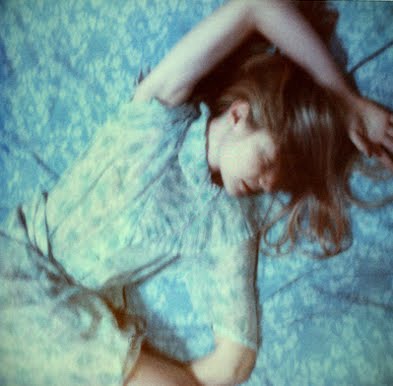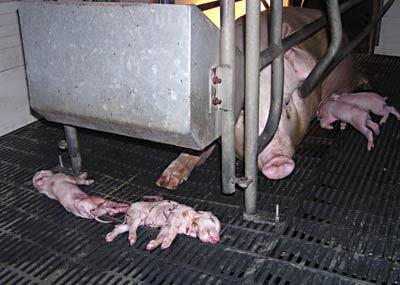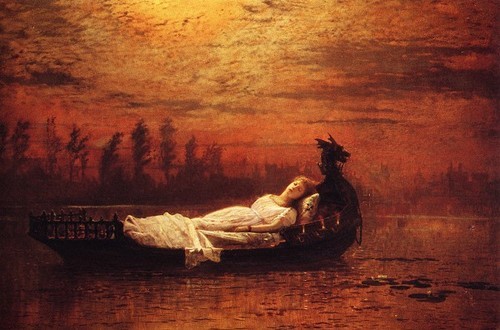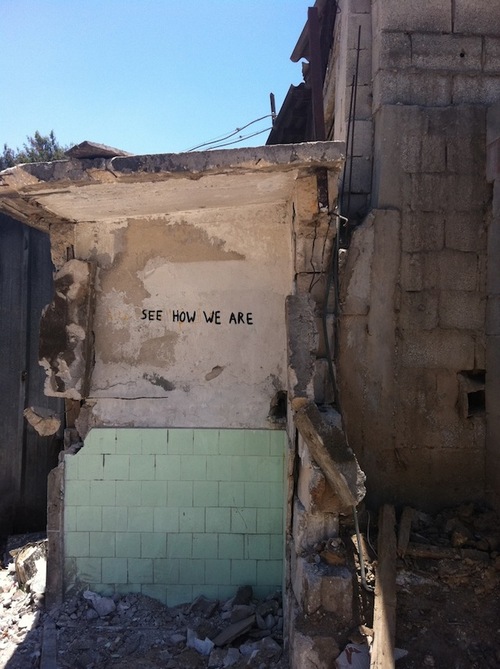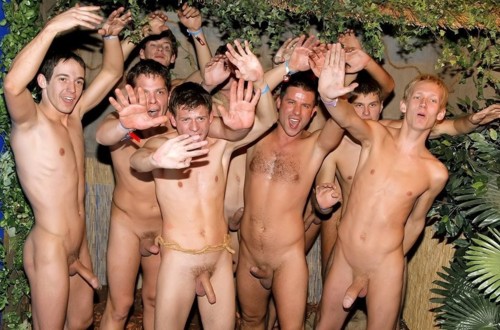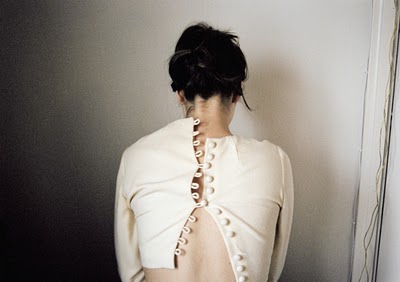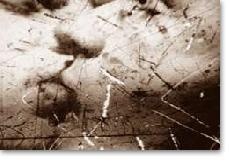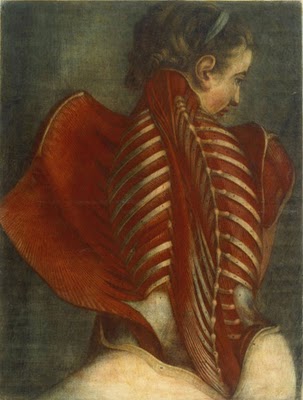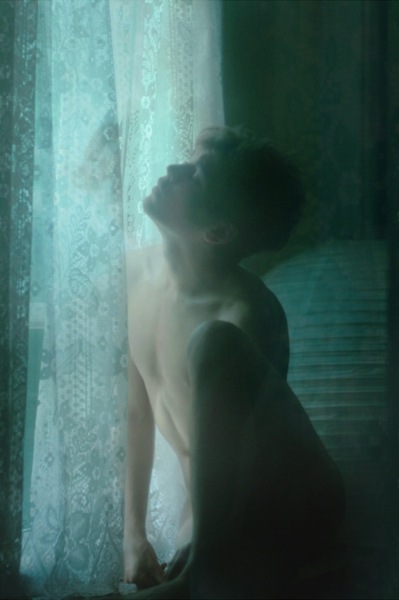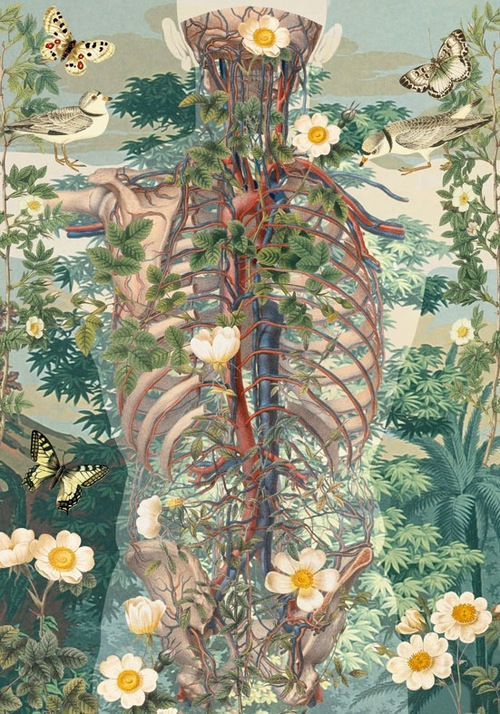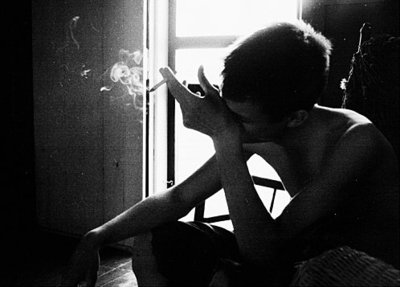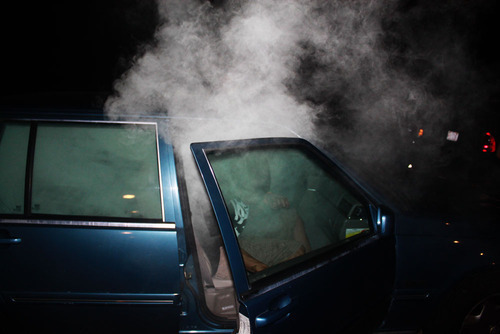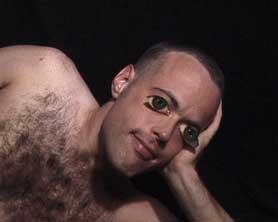
1. Wrik Mead: Out of the Closet (an interview) (1996)
Wrik Mead is the maestro of low-tech portraiture, working with a small group of friends to produce a gestural cinema of ritual and intimacy. Invariably photographed in super-8, his films are pointedly grainy, dirty, scratched, and ravishingly beautiful. They often last just three minutes, the length of a super-8 roll, showing a one-person performance directed towards the camera. If he prefers his actors naked, it is because he hopes to read, in their exposed flesh, the way the body has been bent to the rule of another’s desire, subject to the gravity of opinion and consent. His figures struggle against the desire to conform, longing to touch, to be allowed to express a same-sex abandon. Over and over, Mead renders the act of “coming out” gay allegorically, showing his actors struggling against unseen forces which he creates by shooting one frame at a time. These live animations push and pull at the body, trying to find a way out of a universe they seem to inhabit alone. Pitilessly unromantic, often pessimistic, but filled always with a luscious materiality, bargain basement means, and a wry sense of humour, Mead’s darkly drawn schemes of desire mark him as a potent new force of the Canadian fringe.
WM: I was a very bored waiter who’d been in the restaurant business for ten years and saw painting as a hobby. I had a friend who’d applied to the Ontario College of Art and told me about the process — that you sit with three different teachers and they critique your work. That interested me. I didn’t want to go to school; I just wanted someone to look at my work and tell me if I should continue. Three months after the interview I got a letter saying “You’ve been accepted.” I’d never taken an art class before, so it was a struggle at first. I thought a colour wheel was a way you applied colour, like a brush on a wheel, and I was too proud and embarrassed to ask what I didn’t know. That’s how I became friends with John and Dan [Moyen, the subject of Deviate] — we were the lamest in the class. I tried to get into film my first year, but everything was full except for an animation course which was terrific. It was a very basic introduction, but I didn’t take it too seriously because what I really wanted to do was paint. The film thing was just to have fun. In second year I was still focused on painting, but I wasn’t learning anything. Basically I was getting studio time when what I wanted was to learn the right brushstroke. The teachers were alcoholics who would yell at us for showing up to critiques which they’d scheduled — and that was it for painting, I gave it up. By then I’d started taking photography courses — I’d never done any of that either. I met Nancy there, Nancy Drew — the waiter at the Cameron. D’you know her? I loved her approach because it was like mine, playing around with what was possible, whether it was solarization or double exposure. We didn’t have an enlarger so we used a slide projector, putting negatives and objects inside. And because there was no timer, you’d just flash the paper for a second, and we found amazing things there. That same excitement about discovery leaked into my filmmaking. I approach them both the same way, less technically than aesthetically. I took Ross McLaren’s class for two years, and he showed me there were others who did crazy things with film, that you didn’t need a love story or an action thriller to be a filmmaker. I never had the skill to make perfect, straightforward looking things, so I had to do something else. I was never one of those photographers who took profound pictures of real life situations — I don’t see them. I like playing, building up an image using layers of glass and collage until I get the right mood.
MH: What did you make of the experimental films you saw?
WM: I didn’t connect with a lot of it; I still don’t. But a few of them get me so excited, like the beautiful colours in Stan Brakhage’s films. When I looked at work, I wanted to steal emotions. I would watch how someone could take a pan over a wall, slow it down, add a red filter, and all of a sudden it looked horrifying. I liked bits and pieces of movies for very selfish reasons. The first film I made is called The Face of Freedom, which has my friend David in it. I didn’t distribute it because it was too corny to take seriously. It was an experiment that showed me what was possible. Years later I asked David if he would be in another movie, Closet Case, and I reworked the same soundtrack. Both are about getting out of some- thing. In Freedom, David was wrapped in this huge fishing net in a smoky red room. I asked him to move very slowly and shot it a frame at a time, which is how all of them are done now. Well, no, I have done things which aren’t like that, but I don’t like them. [laughs] It’s a drag — you get to a point where everything you do now goes into distribution and you have to live with it. I wish I could erase certain films and only keep the good ones. At the time I think they’re good, but a year later… Anyway, The Face of Freedom was too grand and too silly. He breaks out of the net at the end and walks past the camera and that’s the end of the film.
MH: Why shoot a frame at a time?
WM: I can’t hire real actors so I work with friends, and they don’t know how to move properly. By shooting single frames the movement’s abstracted and it gives me time to direct people. If we’re shooting in real time and I want them to move from that tree over to the stairs and they turn, I can stop them and veer them off in the right direction without it looking too bad. And I loved the magical things you could do with animation, like in Warm. He can be up against one wall and then appear against the other, or dragged across the floor without anyone pushing him. I did do some things which I shot in real time and I hate them; I wish I’d pixilated them.
MH: Tell me about It Helped My Mind Relax (3.5 min 1987).
WM: Many of the films are portraits; I ask people to do things that are my interpretation of them. My brother Kevin and I were going to art school together. He was a chronic smoker, very impatient, always worrying, didn’t know what he was doing at school, skipping classes, panicking. We lived in a one-bedroom apartment and the living room where we shot the film was my bedroom. I had a very simple idea. I had one roll of film and wanted to shoot without editing. The roll of film that’s in distribution is the same roll I put through the camera.
MH: Kevin never leaves the couch in the film and he’s alone until someone appears briefly to light his cigarette.
WM: That’s me, but I’m wearing sunglasses so no one would know. I have the cable release in one hand and with the other I’m lighting his cigarette. I thought it was necessary to have someone show up and light it for him. Later on I burn the back of his hand, punishing my little brother on film. I wanted something to set him off because he’s quite complacent; he’s reading a magazine, he’s bored, he can’t sit still, he needs people around all the time. Even now he’s a party animal. He can’t be alone. He always used to freak when we were young because I’d be in bed reading and listening to music by myself, and he’d be out with millions of friends and asking me, “How do you do it?” So I wanted to put him alone in a room without being able to deal with it. Burning the back of his hand was meant to set him off. That’s when the blanket entraps him. It chills him out.
MH: What makes it look so gauzy?
WM: All my films are shot through glass. I wanted to get the feeling that you’re watching someone through a window. I put dead flowers in front of the glass so that there’s something between you and the scene. There’s a shine off the glass, the light making layers. I wanted to break all the rules. The only lighting for Relax is from the table lamp beside him. My instructors told me, “You can’t do that,” and I said, “Oh yeah?” For me they were all tests, playing with the medium, seeing what’s possible.
MH: Your next film, What Isabelle Wants (3 min super-8 1987), was made in the same year.
WM: I did Face of Freedom, What Isabelle Wants, It Helped My Mind Relax and Jesus Saves all in third year at art school. Isabelle’s a dear, dear friend, but a very selfish one. We were shopping at Goodwill, and I found the doll that’s in the film and thought it was the most brilliant thing I’d ever seen. I fell in love with it. I’d never had a doll before in my life. I’m a fag, but I’ve never played with dolls. And she wanted it. I had it at my place for about a month and every time she came over she had to have that doll. One of those nights, about one in the morning, she bugged me about this doll and I said, “Okay, if you act in a movie for me, I’ll give you the doll.” It was very late, we were both stoned, and she was wearing the same crinoline dress the doll wore. We shot the whole thing in an hour with a couple of five-hundred-watt bulbs. It was something I’d already thought about, and when it had to happen, it did, and I loved the immediacy of it. Relax was shot in an hour as well. I find if I labour over something too much, baggage gets in the way. The film is about her wanting that doll so much, and she has such a way of getting what she wants that she makes it get up on its feet and come right on over to her, and she’s got it in the end. Then she says, “Isabelle gets.” I used outdoor film indoors to give it a warm look and had her dress up like a ballerina. With her white hair she was very colourful, like we all were in the punk rock days, but in the background there’s a pitchfork, and all sorts of rusted equipment. So there’s a very pretty, childlike person with this mechanical background. She moves mechanically, like a big wind-up doll. In the first films I did I always yelled, directing the action like crazy. I still do that, I skip being friendly when it comes to making the film. I want it the way I want it; the Mr. Nice Guy routine dissolves. I feel like a different person. In real life I would never tell people what to do, but in film you’ve got to. I was pretty passionate about making films, watching films, making art. I had a fantastic time at art school after I gave up painting. In films you can build props and proportion and depth, you don’t have to paint it.
MH: It’s funny you arrived all at once at your style in film.
WM: I think that’s a flaw. I wish I weren’t so in love with that way of making films. I wish I could do something different. I try every now and then. The sad truth is, it’s not interesting. I still find there’s a lot I can do with pixillation. I’m not beating myself up that much. I wish I could get as excited doing things with film that aren’t pixillated. In third year Face of Freedom did it for me; I knew it was what I could do.
MH: Jesus Saves (3.5 min super-8 1988) is different.
WM: I’ve always been fascinated by horror films, I’ve watched all the Halloweens. Hellraiser is one of the most beautiful films I’ve ever seen. I wanted to make a film that would disturb people, unsettle them without necessarily having blood and guts. I’d been a vegetarian for fifteen years and found the process of butchery that many took for granted horrifying. At the time I was preaching a bit. I wanted meat eaters to see what I saw, and putting meat on the shelf wasn’t enough. I had to push it one step further and actually make this butcher a little more twisted. One day he realizes his customers are the meat they eat. He tells his story to a priest in a confessional on the soundtrack. My favourite shot was the last in the film. I happened to see a nun walking by and had my super-8 camera. Everything I’d done was so staged, but this was totally spontaneous. She’s walking with her groceries and I’m setting up my camera — omigod, omigod, she’s going to go — and I didn’t say anything, but she turned on her own and waved at me and then went inside, and I knew that was the end of the film.
I shot pigs in butcher shops, pigs hanging in windows, and the “Jesus Saves” sign I happened to pass on the street, so the film built piece by piece. Then I wrote the soundtrack, and we watched the film while we recorded it, plugged directly into the projector, so when I say, “I nearly cut the nose off one of them,” you see the animation panning down the pig with its nose cut off. At the end I say, “I nearly cut my damned finger off,” and the animation shows someone chopping their own hand off and putting it in the frying pan and serving it up after. The optical printer was used to edit all the parts together without splicing tape. It was all optical printed, from super-8 to super-8, just for economic reasons. Recording the soundtrack directly onto the mag stripe of the film eliminated the expense of optical sound. I couldn’t afford anything else. I really liked the films but didn’t expect others would enjoy watching them. I certainly didn’t expect them to be as interested as they seem to be now. They were little art projects and that’s it, and my film teacher had no idea what to make of them, so I assumed they were bad. Isabelle and Dan were great supporters; I could’ve pooped on paper and Dan would’ve loved it.
After I left school, I dropped film. I’d been exhibiting artwork in galleries and I guess it was in 1990 that Kika Thorne called me. I didn’t know her at all. She said she was programming some super-8 stuff, and I asked her how she’d heard of me and said you don’t want to see what I’ve done. But she programmed them in a series called Token and Taboo and that’s when people started talking to me about them. Kika was so enthusiastic about them that I started thinking about film again. Later Kika asked me about showing in another program she was putting together, and I didn’t want to show the old stuff so that’s when I made Gravity (4.5 min 1991).
I wanted to do something different because I felt that those were my student films and I didn’t want to repeat that — I wanted to move on. Gravity was my getting back to rediscovering film and super-8. I was doing faux finish painting, and Dan was my business partner and my absolute best friend in the world. I loved him to death; he knew every secret of mine. We were having a feud because he was always passing out and very tired. He was HIV-positive, but didn’t know it. He went into the hospital with a bit of a cough and three months to that day passed away. It’s hard for me to talk about it; it turned my world upside down. Just before going into the hospital, he was moving in with a boyfriend and I was moving into his apartment. He had this great apartment that was really cheap, and he didn’t want to give it up in case things didn’t work out. When Dan passed away, I went down to tell the super. Twenty-four hours later I was locked out of my apartment and told I was a trespasser, that I wasn’t on any lease. I couldn’t believe he was gone. It was far beyond anything I’d ever dealt with, and then to lose my home… I started working for others, doing a lot of film work, scenic painting, so I didn’t have to think. In the middle of these jobs, I went to court to get my stuff — I was locked out for thirty days. The lawyers wanted me to ask Dan’s parents to come down in front of a judge and say that I lived there, and I just couldn’t — this is a mother and father who just spent three months in the hospital watching their son die. He turned twenty-six in the hospital, I could not do that to them, they were going to the cemetery every day. When I got back in, I saw my apartment had been ransacked while I’d been locked out. My boom box, 35mm camera, all the super-8 home movies of my childhood, my whole growing up was stolen. That’s when I made Gravity, when my life was nothing more than waking up, going to work and watching TV. It’s all shot backwards. It suggested a cycle that could run backwards or forwards. It was the same either way, you wind up in bed sleeping in the end.
MH: Gravity shows a man waking up, getting dressed, watching TV, then getting undressed and going back to bed, all the while listening to an exercise program.
WM: I was used to being in control of my life, especially at work, but now I was a baby again. That’s what the soundtrack was for me — get up, stretch, move your legs; it’s Jack Lalanne very aggressively telling this lethargic person what to do. The film shows a cycle which opens and closes in bed. I don’t like that film right now, but I do like the soundtrack. I couldn’t have written anything that worked better than what I found. That film got me out of the closet of not making films.
MH: Tell me about Haven (2.5 min 1992).
WM: Haven was a reaction to the RCMP witchhunt of gays in the 1950s. They invented this thing called the fruit machine, which was a box where you looked at lewd images of gay men while holding a bag of crystals, and if you started to sweat, the crystals reacted and set off an alarm. The RCMP also read lists of words while you held the crystals, and certain words showed you were gay: circus, dyke, grass, trees, bagpipe. All civil servants who were suspected of being gay were made to take the test, and if you sweated, you were fired. This experiment was hushed up until 1992 when I made the film; no one had ever heard of it. On the soundtrack I asked my brother to read the newspaper report on the experiments, including the long list of words that would show you’re gay — camp, sew — and as he says these words, the two cartoon characters are getting turned on, you know, like “camp,” that’s a real homo word, that’ll get you going every time. [laughs] They just get right into it as soon as they hear those words.
MH: How did you make the characters?
WM: They’re parts cut out of magazines. A piece of thread runs through each of the parts, so they have enough flexibility to move. This animated stuff comes from my art work. I do a lot of collage work, cutting out the guys and putting them in scenarios, so this film was an attempt to bring my film and my art together. The collage work shows slightly warped gay domestic scenarios. There’s one where a guy makes breakfast wearing an apron, and the other is like Dad coming home from work with a three-piece suit and a briefcase, only he’s wearing a bondage mask. Haven allowed these characters to move. I made the film from start to finish, from making the characters to shooting a single roll of film, in a couple of hours. I just thought, oh I’ll make a film today. When they start having sex, the camera tracks in and you see very blurry pornography stuff, it’s the nasty, close-ups of anal sex and blow jobs and stuff like that. After the guy orgasms on the soundtrack, it pulls back to the cartoon characters.
MH: I thought the out-of-focus footage was a direct response to the voice-over, which is attempting to code the homosexual. There are two people with big sad eyes, sad because of what he’s saying, yet as they come together we can’t really see this, their feelings. You
can’t hold a bag of crystals and understand anything about love, and you can’t hold a camera in front of it either. That’s why it has to be out-of-focus.
WM: I find really graphic stuff, especially close anal penetration, not as beautiful as the blurry stuff was. I wanted something smutty that wouldn’t be graphic or greasy, which they always are in pornography. When I was through, Michael Balser curated it for the “Bodies In Space” show, and I was terrified. I thought it was just a silly little film and that people were finally going to figure me as an idiot. What does he do with his spare time? He gets these little characters to do the wild thing. But people seem to like it.
MH: Warm (4 min 1992) shows a naked man alone in a room struggling to get to his feet, to approach the camera, and then a hand extends and pulls him free, and he embraces his lover.
WM: Warm was the first film I started storyboarding in a loose way. It’s about being alone and beating yourself up. I’m no good, I shouldn’t have done that, I won’t succeed. The force that’s knocking him around is actually himself. It’s not until someone reaches in and says you’re all right that he calms down, the soundtrack calms down. I wanted to make another in-camera film but when I got the footage back the pace was all wrong. He was falling into walls too slowly, falling down too slowly. It just didn’t move at all. So frame-by-frame I marked out where it needed to change — between frames 895 to 950, shoot every other frame, from 950 to 1050, double every frame. It was a horror story. I laboured over it so much to get it to the way it is now I became sick of it; I couldn’t look at it any longer. It took me a few years to pull it off the shelf and make a soundtrack for it. I’ve always had a problem with clothing in films. I love the human body. Clothing always tells the time, so I’ve started removing clothes and getting people naked. It’s much more compelling to watch, more personal, and you can really see what these people are going through, instead of watching their clothes.
MH: Tell me about Homebelly (8 min 1994).
WM: It’s a portrait of Donna. We went to school together, and each summer she would go back to Alaska to work in the canneries. She was always wondering whether to stay in Toronto because of her friends or go to Alaska which felt like home, and the film narrates this dilemma. She’s collected about five or six rocks, each about ten to twenty pounds, and each waxed and polished. She’s travelled extensively and the rocks always go with her. I always said I have to make a film about you and your rocks. So there’s a battle between her sleep and this rock which is trying to wake her up, and I had to be careful that it wasn’t beating her up; it just gently leans up against her. Originally the whole film was just that bedroom scene. Then I wanted to show her dreaming, so I went out into a terrible storm on the island, got frostbite in one finger, and shot the snow and the trees. I superimposed that with the bodies of two women. The first time they appear, the bodies are back to back. The second time they turn to face each other, and in the third they embrace, but their embrace can only happen once she’s made peace with her rock, once her decision’s been made. The rock is an image of her problem. She’s trying to get into this other state, and it keeps waking her. Finally she falls asleep. She’s having this dream, and just before the two women reach for each another, the rock wakes her and won’t let them. Because the rock moves when she’s awake, the line between dreaming and every day is blurred, as if it’s all going on in her mind. Donna wasn’t too thrilled about that angle. Though she’s lived with and dated women for many years, she’s now dating a man. She felt it named her as a lesbian and she feels very bi, very open, but if I’d used a straight couple then she would have been named as a straight person. It had to be one or the other.
MH: Closet Case (3.5 min 1995), like Warm, shows a single male figure caught in a room, trying to rise and move towards the camera, but always pushed away by unseen forces.
WM: I called it Closet Case because I wanted to make a coming out film; it’s my ode to the gay world. I think people, even gays, forget how difficult it was. I had it relatively easy. When I was eleven, my mom told my brother and I that if we were gay that was fine, that it would be a very difficult life, but it was okay with her. I broke my virginity with a guy when I was thirteen. He’s now straight and works as a butcher. We got totally pissed drunk and it happened. I woke up the next morning and it absolutely horrified me. He came to my place the next morning, my straight friend, knocking on the window like nothing was wrong, “C’mon let’s go out,” and I said I wasn’t feeling well and then I couldn’t be friends with him anymore. We’d done something that was too real for me, something I’d tried to repress. All my fantasies while I was masturbating were always about men, ever since I was seven years old. But I was dating lots of women, sleeping with lots of women, trying to prove something. I had a negative feeling towards homosexuals when I was a teen because you’re always told you’ll want to wear dresses, lisp, and have a limp wrist. You’ll be a waiter or hairdresser for the rest of your life, or worse, an artist. I don’t think a lot of people understand how horrifying it is to grow up and think what you are naturally is bad. I think I had it easier than most and still went through hell.
When I was eighteen I slept with my best friend, whom I didn’t find sexually attractive in the slightest. But I thought, here are all my straight friends sleeping with any woman just to get inside them, and if I was truly gay I should be able to sleep with any guy. My best friend was hot for me and constantly pressuring me to sleep with him. Well, I did it one night and I was horrified, crying on the inside that this is not right, I don’t love this person, I should never have done this. I remember walking home after and thinking I’ve got to be straight, that was too terrible for me to be gay. It’s absurd to think I’ve gone through that, but there was no encouragement. No one ever said, “Oh Wrik, you like that guy Bill, isn’t that sweet.” They would say you’re warped, you’re a faggot. Many people in my high school were beaten or tied up with pink ribbons. You watched TV and the only homosexual you ever saw was the object of ridicule, or a drag queen, or assaulted. There was no one to look up to, no regular guy who was a phenomenal person. Then there’s the negative stereotypes, that if you’re gay you must sleep around. You know, Steve and I have one of the best relationships of anybody I know. It’s been seven years now, and it’s still absolutely phenomenal. He’s the kindest person I know. It’s a lot of work but… Closet Case came about because of all those struggles. Like when a friend told me about his brother who made him suck him off. The film itself is very simple. It shows the struggle of a man to come out of his bondage suit. I wanted to do a three minute, in-camera film. There’s no splicing; everything’s shot in sequence. I was frustrated that (ab)Normal was taking so long, and I thought I’d burst if I didn’t do something. I wanted to re-do Face of Freedom, my first film, keeping the soundtrack, but narrowing the scope. This film isn’t about everyone’s freedom, but gay freedom. I sewed the costume in a lovely tan cotton with light brown leather straps. I didn’t want a bondage outfit of rubber or leather. Because it’s made out of cotton it’s softer, it’s a gentleman’s bondage outfit, with a strait jacket and mask.
MH: You’d never collaborated with anyone before making (ab) Normal (19 min 1995) with Isabelle Auger. Why the shift?
WM: I’d never dealt with a crew, so I thought it would be out of my league to do a twenty-minute film by myself. And I wanted Isabelle to start making films again. So I asked her, why don’t we make one together? There was a Canada Council deadline for film grants a week away and we didn’t have work for a week. That’s when we came up with a storyboard and a budget. We think very much alike, we see the story happening rather than writing dialogue. I had an idea for a film where someone would be caught in a box that would get smaller and smaller. That’s one idea Isabelle fine-tuned. She thought of a crate with light coming through the slats, which worked wonderfully. But that couldn’t last for twenty minutes. So maybe we should make a bunch of short films. I had an idea for another film where this guy masturbates with something which comes to life. It would be a dildo that would run in and out of the body, and wouldn’t that be cool to pixillate. Then Isabelle said, what if there were two guys? We’d bounce back and forth until we found what we wanted. She wanted to make a scene where things are stripped away, objects disappear throughout the scene. There’s a couple and while he’s frozen in front of the TV, she opens the curtains, and as soon as she walks away from them, they disappear. Then she waters the flowers, and as soon as she leaves them, they disappear. She picks up the phone, as soon as she hangs up, it’s gone. At the end, when the camera’s closing in, whatever’s at the edge of the frame, just before the camera passes it, it disappears, and when nothing’s left in the room they see each other and embrace. That whole scenario was organized by Isabelle. None of these ideas could last for twenty minutes, so what about piecing them together with something that connects? As we talked, we realized that the common theme was couples — they all had couples in them.
MH: Was the progression of couples deliberate?
WM: The straight couple are so wrapped up in the objects in their lives they don’t appreciate they have one another. They take one another for granted and don’t realize how lucky they are — and find out at the end when everything’s disappeared. The box scenario was about two women who smother each other and disappear. The last scenario is about bad timing, when people aren’t in tune with one another. Two men lie in bed, one wants sex but his partner has rolled over, asleep. A dildo appears and crawls all over him, and when he’s done he falls asleep. Then the other wakes up because he wants to have sex but it’s too late. The title insists that these couples are all natural, from nature. Homosexuality is natural, straight is natural, lesbians are natural, the way we fight with each other is natural, so we used nature and animals as themes to draw it all together. The scenarios are connected with landscape pans which people talk over. Initially we were going to appropriate phrases from talk shows but I couldn’t find any gay representation; gay couples only talk about politics, never their intimate relationships. I taped every talk show for two months and it was painful. There’s all these straight people going on about themselves, but gay couples have no part in any of this. That’s when we decided to do something more personal. We asked a couple of friends if we could record a conversation about relationships. Carol is a new lesbian; she’s mostly dated men but now sees women. John used to be married but now he’s gay, and it was important for us to have people who could talk about men and women, to get gay and straight viewpoints.
MH: They speak a lot about power and intimacy and the heart’s turf, which wraps well with the wordless couple scenarios we watch throughout the film. Each couple seems to play out their lives in the background of these words. They’re like a Greek chorus.
WM: We wanted to hear the bad stories, the relationships that went awry, like John’s marriage ending badly, but when it got to taping he didn’t want to talk about it. But the more we played the tape the more we heard. We gave them the background of the film, and brought the storyboard and talked them through all the ideas, and while we didn’t tell them what to say, in the end Carol says it all comes back to territory and then she laughs because it’s what she was supposed to say.
MH: Deviate (3.5 min 1992) is a work of mourning that returns to your friend Dan. It seems motivated by anger at how he was treated after death.
WM: Yes. The priest at the service made many fatal errors in describing Dan, saying a young man in his thirties shouldn’t be deprived of his life. He was twenty-six! We all looked at one another. He said something about being a practicing Christian. Dan studied Buddhism. His parents were devout Catholics, but he was one of the great experimental thinkers at art school. I was shocked that he wasn’t kicking the grave open. If anything was going to make him come back, this service would have. But to make his parents feel better, we all had to hear these lies. They invited people Dan hated, like childhood friends who would beat him up for being a faggot. He didn’t like his parents, never saw them. We were his family, but because he didn’t have a written will, the decisions were left to them. It broke our hearts. We knew he would’ve been horrified to learn he’d ended up in a devout Catholic cemetery out in the middle of nowhere with electric towers all around. It just hurt so much to deal with all of that. I was in the hospital with him at least every other day for three months, and he disintegrated quite rapidly. It was very difficult to watch, for his parents as well. His mother and sister and I became very close. I helped them get through a couple of really difficult moments. It was frantic. At the funeral his father embraced me and said, “We consider you family, anytime you want, please come visit, you’re wonderful people.” I was asked by the curators of Clamorous Intentions to make a film for their AIDS art exhibition, but the film was secondary to the experience which led to it. I talked to Claire about it (she grew up with Dan, they were childhood friends), and another childhood friend, Dave Sermon. We’d been talking about going up to the grave, and the film gave us a reason to go. I decided not to cry, but to celebrate our lives and our memory of Dan. We even poured a little champagne onto the soil so he might get a little drink if he was thirsty. We were looking for flowers or something to take to him and it happened to be Halloween time. I don’t know whether you can see it in the film, but there’s a pop-up skeleton head, a toy skeleton on a spring. We took him a bouquet of flowers with this little skeleton head sticking out and left it there. Apparently his parents came soon after and were horrified at something so satanic and evil, and I was sickened, I have done an evil thing, I’ve hurt two people who’ve suffered enough. Later I talked to my friends and told them we’d really hurt the family. They laughed and said we had a wonderful afternoon, it was so difficult to go out there, that was our ceremony. We were his family, the ones who really loved him, and we hadn’t called them and told them how hurt we were by their Catholic rituals. If you said the word “shit” in front of them, they’d dismiss you forever, so don’t be upset. We had a wonderful day. We sat on his headstone and talked about Dan, and I brought a tape recorder along. I wanted the real Dan, not all this phony priest shit about how great he was. He was a pain in the butt. He was the most beautiful human being on earth — that’s who he really was. But it’s all said in love. I didn’t care how the film came out. That’s Dan on the couch yelling at people and saying “fuck off.” Claire took that of Dan when he was fourteen, and I slowed it down so all the zooms were a little gentler. I projected it inside the frame.
MH: Why the frame?
WM: The old artist in me. It’s like a bedside tableau. I have framed pictures of Dan all over the place, so it was like having a live bedside picture of someone you love. With flowers and a little plane because he collected them, and a watch. Not much happens visually; originally that bedside image was going to be just a part of the film, but I wanted people to listen because the words were so important.
MH: Why the title Deviate?
WM: Because the film was about Dan. He was the thorn in normal people’s sides. He thought differently and was aggressive about it. He would tell you you were stupid for being straight, you’re just following the norm, you’re not really straight. He was really into extreme thinking — he would pick his nose because he knew it was socially unacceptable, he would tell you the graphic things he’d do while masturbating because he knew it would make you uncomfortable. That’s the kind of guy he was, very aggressive and the sweetest friend you could ever have. He left us in a way no one could have guessed. He was such a life force. That’s why I called it Deviate.
Wrik Mead Filmography
It Helped My Mind Relax 3.5 min 1987
What Isabelle Wants 3 min super-8 1987
Jesus Saves 3.5 min super-8 1987
Gravity 4.5 min 1991
Haven 2.5 min 1992
Deviate 3.5 min 1992
Warm 4 min 1992
Homebelly 8 min 1994
Closet Case 3.5 min 1995
(ab)Normal by Wrik Mead and Isabelle Auger 19 min 1995
Frostbite 12 min 1996
Originally published in: Inside the Pleasure Dome: Fringe Film in Canada, ed. Mike Hoolboom, 2nd edition; Coach House Press, 2001.
2. The Films of Wrik Mead
The films of Wrik Mead are psychodramatic by inclination, first person narratives of desire and accommodation. Like many psychodramas they feature a single protagonist who attempts to negotiate a pre-linguistic surround, trying to find the join between themselves and the outside world. Often featuring brooding minimalist industrial soundtracks, these films pit the body against the word, as the body’s desire rubs up against its own naming, trying to free itself from the narratives of desire which have come to inhabit it. Over and over Mead renders the act of ‘coming out’ gay, and the struggles which ensue, staging the body as the arena of conflict. Invariably photographed in super-8, they are pointedly grainy, dirty, scratched, and suffused throughout with a mottled surface that evokes a low-tech sublime. Often lasting the length of a super-8 roll he deploys the camera’s intervelometer function – allowing it to expose a frame of film at a time – to great advantage – often drafting a one person ‘performance’ directed towards the camera. Their very frontality and fixed framing enlists the camera as part of these performative tableau, asking that we read these gestures, these bodies, as the effect of representation. That these representations could change, that a celebration of sexual difference could be possible in cinema, impels much of Mead’s work.
What Isabelle Wants (3.5 minutes 1987) is a dreamy fairytale fragment. Cast in a hazy pastel palette, we watch a white haired mannequin stir to life, her long limbs rising into an erect sitting posture, before arms stretch out towards the camera. On the other side of the room, or the other side of this fairytale universe, a small girl-doll stirs to life, and makes its way towards the summoner. She takes up the doll and cradles it, the doll presenting an image of herself in miniature, this unlikely caress a narcissistic marriage of the present and its antecedent. Photographed through a large sheet of glass using an intervelometer, Mead directs the actor to move very slowly, so while the camera is only exposing a few frames per second, the arrested gestures simulate a real time regimen. All of this adds to the effect of a doll universe, of the complicity between ourselves and the images which continue to animate our own behaviour.
This hazy pink baby doll universe denotes a desire which begins in childhood, and whose roots in infantilism never completely leave us. The woman in this film has grown up in the image of her own childhood and inhabits it still, and if this movie may be read as a metaphor or allegory, then she might be taken to represent the sum of our early years, beckoning still across a field of toys which remain perfectly attuned to her every whim and summons. This wordless place conjures the infantile roots of gratification, and the auratic, animistic world of wonder whose heritage is too rarely claimed.
It Helped My Mind Relax (3.5 minutes 1987) was made in the same year as What Isabelle Wants, and like it features a single protagonist, photographed through a sheet of glass using an intervelometer. The scene shudders with a golden glow, a single male figure waits on a couch, smoking cigarettes. Nowhere lies an explanation for the agitated waiting on the couch, and while this scene is clearly a prelude for actions to follow, these are never detailed. What we are witness to instead is an in-between time, a time between actions, like a camera perched in a doctor’s waiting room. A laboured mechanical breathing sounds through the track lending tone to this narrative of anxiety. A second figure, a double of the first, appears twice in the film. Firstly he lights the cigarette of the lead, who blows out the match and makes him disappear. Later, this shadowy second stubs his own cigarette out in the ashtray at the same time as the first, leading him to recoil, as if stabbed by pain. A series of frenzied agitations follow, finally ebbing into stillness as he wraps himself up in a blanket, undrapes himself, and begins to smoke again. His waiting solitary is joined here by his dreamed double, by a thousand small accidents waiting in even the most benign domestic setting, his mind converting the world around him into an anxious site of danger. Relax is an emotional vignette, a portrait of anxiety realized in the smallest of everyday settings.
Jesus Saves (4.5 minutes super-8 1988) is a vegetarian manifesto cast in the form of a confessional. A slowed voice narrates the tale of a butcher increasingly troubled by his bloodletting while a priest listens on, offering encouragement and forgiveness. The butcher finds it difficult to separate the food he is preparing from the customers who ask for it, and as his own flesh is made to mediate between the two, his own body is made to inhabit a world of meat which is sectioned and sold. “I mean if they ha d any brains they wouldn’t be in the shop” he says about the pigs he slaughters, yet there is already in this statement a terrible ambiguity. ‘They’ might refer either to the pigs or the customers, and he stands poised between the two, knife in hand. His knife is an instrument of division, and by staging this confusion in the confessional, Mead suggests an equivalence between the butcher’s knife and language. Our words also divide the world, providing a linguistic perimeter which clearly separates the object s which surround us. It is this perimeter which has broken down, as a terrifying unity of meat envelops him. He seeks absolution in the words of the priest, asking him repeatedly for forgiveness which is granted in the film’s close. While the church has been sought as an alternative vision of unity, as a coherent cosmology able to account for the actions of the world, he is delivered instead into a final act of denial. The words of the priest, the father, separate him from his sins of misrecognition, and so enact a last divorce between subject and object.
Gravity (3.5 minutes 1991) features a solitary protagonist waking from his morning bed, getting dressed, pausing to watch a section from a gay porn video, taking his clothes off again, and lying asleep. These simple actions are framed by a hand-drawn black m arker which encloses him in a wavering frame, underlining his status as an image, a picture to be viewed. His waking is accompanied by an exercise program issued from the radio where a male voice exhorts his unseen constituents to lift, bend and stretch. Once more Mead returns to his familiar themes of the body and its disciplines, the way it is bent to the rule of the word, in this instance a numerical succession of exercises designed to shape the body’s perimeter, and to present the body as a piecemeal assemblage which needs to redrafted into a uniform of flesh, subject to a common ideal. “Slow down. Now again. This helps to firm up the knees and above the thighs, it gives you co-ordination and balance, that internal fitness that you will need the rest of your life. This is something that will be with you the rest of your life.” This notion of ‘internal fitness’, the mapping of the outside to inside, is crucial here, the body figured as part of a political compact whose cycles of repetition requires careful regulation. As the sleeper lies once again to begin the infinite dream of the body the announcer asks that he be joined again tomorrow, at the same time, for an exercise regimen that may undertake the tireless regulation of the body which can only be provided from within, via conscience, each of us inhabited by the police of our own prohibitions.
Haven (3.5 minutes super-8 1992) opens with a clear blue ground on which the film’s entitlement appears. When the titles fade away the blue lifts to reveal a bedroom setting entirely comprised of catalogue cut-outs. Two men meet on the bed, dre ssed only in white socks, with large sad eyes and enormous hard-ons they caress each other, enter each other, find oblivion. On the soundtrack a cut-up radio voice narrates a scientific experiment: “An individual peered into a narrow opening of a large bar where sometimes nude pictures from magazines were shown. A camera reported the person’s pupil size as each new image was flashed. The eyes of the male gaze for example lingered on the genital areas of males. To identify gays Professor Wake proposed reading a list of homosexual words to an individual who is holding a mesh bag of crystals. Only a gay person would be stimulated to sweat. The word list he compiled included: surface, bagpipe, blind, can, fit, throw, pout and restaurant.” Shortly after the announcer concludes the camera tracks in to the image throw ing it out of focus. The sounds of sex and birds chirping continue as before, as the screen, now resolutely blue, remains out of focus for some 40 seconds. Finally the camera tracks back from their lovemaking, restoring focus, showing them frozen in a postcoital embrace. They remain perfectly still as the camera continues to track back, showing them as a postcard set against a starry sky of galaxies. The photo tumbles out of the universe, and then each of the lovers rockets across the night sky. The movie is over.
Haven narrates the staging of homosexuality, the film’s opening ground lifting like the curtains of theatrical spectacle, signalling the unveiled as a feast for the eye, as something to be looked upon from the comfortable distance of an unlit audience. But in place of spectacle, of a public circumstance, we are delivered instead to an intimate bedroom scene where the sad-eyed cut-out caricatures of two men begin the gestures of love. Comprised of magazine clippings, their bodies appear before us as media fragments, as Frankensteins culled from the Sears catalogue. This implosion of private and public is underlined in the radio chatter which accompanies them, as a male announcer pronounces a test for the gay life. He insists that words are enough to delineate ‘the homosexual’ from ‘the heterosexual’, that sexual difference is a question of naming, and that it has taken root in our syntax and grammar, that a series of associative words: throw, pout or restaurant for example, will be enough to trigger a response which will definitively ‘show’ the subject to be homosexual. He insists that language stages homosexuality, that its aberrance is a linguistic dysfunction, that the space between a thing and its representation has been troubled, mistaken, or mislaid.
Mead deploys a simple strategy to undermine these assumptions, drawing the camera so close to its subject that it dissolves into a hazy blue abstraction. In doing so he suggests that the act of love is finally unrepresentable, that desire cannot be reduced to a series of schemas. In a tender and understated fashion, Mead inveighs against the relentless and insidious linguistic scrutiny exercised by a normative heterosexuality, as it polices the borders of difference and desire.
Deviate (3.5 minutes super-8 1992) is an elegy for dead friend Dan Moyen. Framed with careening pans over grass, the bulk of this memorial is taken up with a nightstand tableau, flowers and timepieces gathered round a gilt framed television set which shows Moyen seated on a couch in a slow pulsing zoom. Two friends speak on the track, gathering a disparate host of reminiscences – of the time he hugged a friend, of a terrible argument, his love for make up, and of a last lingering dream years after his death where he’s unaware of the date (because he’s already dead). This warmly drawn minimalist portrait is contrasted with his final resting place – a Catholic cemetery where the bones of strangers lie as neighbours. The film closes as one friend reads an officious statement of piety about the church and its burial grounds as the other laughs and shrieks. Here the official memorial is contrasted with memories of a shared life with friends, and our rites of grieving shown to be hopelessly inadequate when those who have led a ‘deviate’ life passes on.
Warm (4.5 minutes 1992) narrates the space between desire and its realization in a four minute epiphany of solitary, longing and male-male desire. Warm, like the rest of Mead’s work, was photographed in super-8, but this is the first of his movies to be blown up to 16mm and all of his movies thereafter would follow the same pattern. Because of its more user friendly gauge it is the most widely seen of Mead’s work, and manages to summarize all of his themes and obsessions. It’s photographed through a sheet of glass and the 16mm blowup was made without cleaning the film, suffusing the scene with a hazy materiality, ensuring a wondrous texture of grain, dirt and scratches. A naked man is glimpsed in the corner of a derelict basement, where windows hang against brick, offering views of enclosure. Photographed a frame at a time, he makes several attempts to rise before an unseen force pulls him earthwards. He struggles against it, moving towards the camera, reaching beyond it, before being driven back to the wall. Finally a hand extends into the frame and he grasps it and is pulled out of his solitary, into an embrace with his lover as the camera circles their embrace. A thumping mechanical track punctuates proceedings, lending an industrial cadence to this psychodrama of desire. The unseen forces at work in the film constitute a ‘normative’ heterosexuality, and his struggles to rise, to become erect, are an attempt to name his desire, to acknowledge his need for a man in the face of an enveloping homophobia. The apparatus, clearly delineated here in the film’s insistent materiality, is shown to be complicit with this movement of enclosure. While his body is irresistibly drawn to his lover he is continually thwarted, bound by the representations which surround him. The camera’s view conjures a history of representation which has insistently pathologized the homosexual, or indeed any desire which cannot be safely coded by church and state. These representations are realized here as an unseen force, as an introjected conscience, summoning guilt in the place of understanding, turning us against ourselves. He has become his own camera, subject to his own ruthless surveillance, unable to break this scrutiny until a hand reaches inwards, joining him with a community of difference.
Homebelly (8 minutes 1994) is a dialogue between two scenes cast in a long night of dreaming. The film opens with a crimson pulse, a heated and grainy abstraction winking out of darkness. As the camera pulls back we see that this is a woman sleeping, framed throughout with a dark line that crops her visage. The camera pans up, passing over stars, arriving via match cut in a blue toned tree line, its stark branches stripped of leaves, the ground covered over with snow. Eventually a body appears, the naked tor so of a woman, wrought in warm hues against the cool backdrop of the forest. These forest interludes occur three times, always with the sound a child’s wind up doll, along with a pervasive wind that howls throughout the film. After the forest we return to the sleeper, and watch a large rock move via pixillation towards her. She pushes it away and then the forest appears again, this time there are two bodies, of two women, appearing on either side of the frame. When we return to the sleeper the rock returns and after a series of dismissals it finally nests on her belly. Her final dream shows the two women touching each other, finding comfort in the long winter evening.
Homebelly narrates the interior state of a single protagonist, whose isolated withdrawal is broken by a dream of love. Her dreams are the more troubled because they are always, in Mead’s universe, cast in the same sex. The landscape is metaphorical here, the wintry treeline emblematizing a desire which has grown too long alone. Desire begins here as an image, as the sleeper’s longing conjures a headless play of bodies that breaks her hibernation. The use of a child’s wind-up toy to accompany the images of the two women evokes an untroubled time before her sleeping, and implies the emotional catastrophe that has driven this sleeper to bed. The rock which moves insistently towards her is also an emblem of her desire, which circles her, is rejected, and finally admitted. This admission of desire draws her back into the world, where she can risk again the wound of joining with another.
Closet Case (3.5 minutes b/w 1995) is Mead’s first black and white film to date, but while its tonality has shifted, the obsessive solitary that has marked this filmer’s work remains intact, alongside his familiar themes of enclosure, the body figured as the site of societal discourse. Six times the camera moves towards a closed door, its efforts of passage ending in darkness, before we see a wrapped and bound figure turning on the floor. In the familiar Mead trope of erection he rises to his feet and begins to jump around a closed and indistinct space. Lights flash as he moves, finally able to work his pants off, and then the straitjacket that encloses his upper body, and then the hood which wraps his countenance. He staggers naked beyond the camera and after the briefest of freeze frames on the now empty scene, the film is over. A minimalist industrial track accompanies his undraping, the film’s title insisting that the revelation or disclosure the film proffers is the body’s desire, which is communicated to itself via the camera. Mead insists on this vicarious route of desire, opening the film with a second skin, a surrogate body draped over the first. This is the skin of received opinion, or media discourse, or peer pressures, and it must be shed before the body can show itself, can reveal its desire to itself. This desire is staged before the camera, because it does not shed representation itself, but rather learns to represent itself in a different way. It is the cost of this difference, the toll it exacts on the body itself, which Mead returns to in film after film.
(Ab)Normal (20 minutes 1995) is Mead’s longest and most recent work to date, a collaboration with school chum Isabelle Auger (the subject of his first film). Breaking from his single take psychodramas, (Ab)Normal adapts a variety of techniques familiar from his previous work and presses them into service as an interrogation of desire. Utilizing a tableau structure which weaves pixillated scenes of four couples with close-up, hand-held pans over a flowery ground, desire is strained through the animal kingdom, as our origins in meat are overlaid with projection, discourse and language. The film begins with a succession of animal couples – deers, chimps, herons, bears, elephants, zebras and lions all tangle with one another in a flickering projection which emphasizes our distance from the animal realm, its status as consumer spectacle, and the way our own desires function as one more product of the media. After a handheld jaunt through a distinctly North American greenery we see the first of the four couples, although this one appears one at a time, the camera moving in a pixillated, animated pan over a woman’s body which then becomes a man’s body. Both wrestle with their flesh, reaching into their own skin, their own perimeter, to dissolve the boundary that separates one lover from another.
The close-up pans over landscape begin again, periodically overlaid with projections of the same animal images that opened the film, this time accompanied by a trio of male voices musing on relationships. “It’s an animal charge. We’re human beings but we have chemical/sexual reactions to other human beings. I turn that off a lot. I keep that closed up…” They speak of the confusing difference between love and infatuation, between sex and intimacy, of the initial impulses of attraction which are invariably sexual and the emotional aftermath which follows. That the divide between physical satisfaction and emotional sharing should be so wide troubles these speakers, one preferring to remain alone, another preferring to please himself first and foremost, all trying to convert their own needs into strategy, into plans for sharing desire.
The second of the tableaus follow, the camera ranging over a vast room where a man listlessly watches TV while a woman roams about the apartment, opening shutters, watering plants, putting on music, flipping through books. Each of the dwelling’s contrivances are sampled by her, each offering another mediated experience. Finally she slumps to the floor and in rapid succession each of the objects of the room are magically removed, finally leaving the two of them alone in the emptied chamber. Their clothes are removed, and finding themselves naked they embrace and make love. Shorn of the distractions of their media extensions, they can arrest their own status as domestic implements, as one more modern convenience, and join with another.
A walk through the natural world intevenes once more, with its male chorus of love. “At first there was this initial nausea in the relationship when you look into their eyes and you’re gonna die, you’re watching them butter their toast and you’re just oh fuck I love that guy and you want to have sex every minute of the day, all day, eighteen times we’ll have sex. And you watch them butter their toast and it makes you so sick you want to kill them and then it’s over.”
Two women appear framed in a wood slatted box – they caress tentatively, and then more forcefully, taking off each other’s clothes, kissing. As their lovemaking progresses the box they occupy grows smaller and smaller, until at the end just a small crate remains with a tangle of limbs contained, it tips end over end, finally leaving the frame altogether. Accompanied by the sound of a painful creaking timber and a laboured breathing, this claustrophic tale of lesbian desire narrates the cost of their ‘difference’, their same sex desire constructing a closet around them, a constricting and inescapable arena in which they’re able to realize their love.
The final tableau shows two men lying together naked in bed, one white, one black. One touches the other who rolls over, while the one left awake is visited by inescapable hallucinations. A shining silver coil appears from between his legs and snakes over the length of his body, plunging into his navel and then exiting through his mouth in an increasingly agitated and solitary evocation of desire. When it finally leaves him he falls asleep and the other wakes, rolling over and trying to touch him, but now it is his turn to lie asleep, leaving his partner as frustrated as he. The camera pans up to a quintet of candles which flare for a moment before extinguishing, signalling the film’s end. The bad timing of these lover’s desires underline both their mutual affection and interest, and their inability to enter into the time of the other, it is only their own interest that they find erotic, not the Other, and so they are condemned to a solitary sleep.
(Ab)Normal signals a shift for Mead, it is at once a summary work and a fully elaborated treatise which moves well beyond his previous work. In it he joins the landscape pans of Deviate, the voice-over dialogues of Jesus Saves and the pixillated tableaus from the rest of his practice, always maintaining a relentless scrutiny on the body as meat and tracking its tireless, often circuitous quests of desire. If he had become one of Canada’s best known chroniclers of the closet, he is now expanding his scope, not content now simply to dramatize sexual difference, but to stage the consequencs of that difference, to break from the solitary of his psychodramatic leanings and enter into a dialogue with an often harsh and unremitting homophobia. If his shift from super-8 to 16mm in Warm signalled his desire to engage with a larger audience, to offer his work up as part of a larger cinematic discourse, then (Ab)Normal takes him one step further, into the dramatization of desire. Pitilessly unromantic, often pessimistic, but filled always with a luscious materiality, bargain basement means and a wry sense of humour, Mead’s darkly drawn schemes of desire mark him as a potent new force of the Canadian avant-garde.
Originally published in Lux, ed. Steve Reinke and Tom Taylor, 2000.
Check out: www.wrikmead.com
